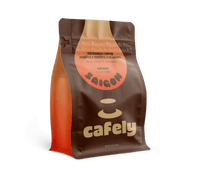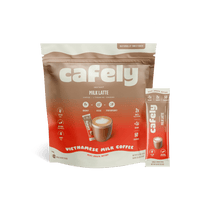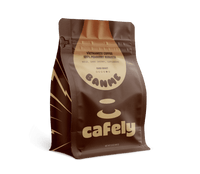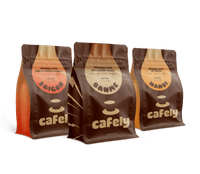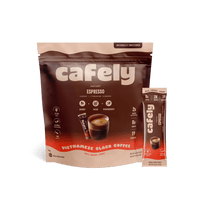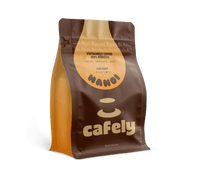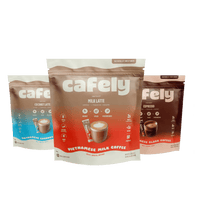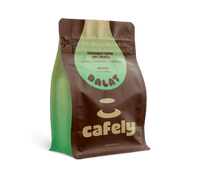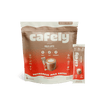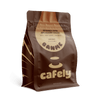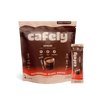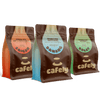There are between 15 and 70 milligrams of caffeine in a cup of tea. The exact amount of caffeine varies between green, black, and white tea. The brewing method and brew time also affect caffeine levels.
Read on to learn about the caffeine levels in green, white, black, and herbal tea as well as how the caffeine content compares to coffee…
Caffeine Content in Black, Green, and White Tea
Traditional tea is derived from an evergreen shrub called Camellia sinensis. This plant is nicknamed “the tea plant” because it produces black, green, oolong, and white tea, among other varieties.
Tea made from Camellia sinensis contains somewhere between 14 to 61 mg of caffeine per 6 to 8 oz cup. The exact caffeine level depends on many factors beyond the tea leaves used.
Here are the approximate caffeine levels in black, green, and white tea:

How Brewing Affects Caffeine Levels in Tea
Brewing time and water temperature also impact the caffeine levels in a cup of tea.
The longer tea brews or steeps, the higher the caffeine level. One study found that tea's caffeine content increased by 29% after steeping tea for 1 minute beyond the recommended time [1].
Tea should be brewed in hot (not boiling) water. When tea leaves are steeped in boiling water the caffeine content can increase by up to 66% [2].
In addition to increasing caffeine, over-brewing tea with boiling water leads to the over-extraction of other compounds. Over-brewed tea can taste bitter, dry, and “oaky” — indicators of over-extraction and increased caffeine levels.
Herbal Teas and Caffeine
While black, green, and white tea all stem from the Camellia sinensis plant, herbal teas do not. Herbal teas are made from a variety of different botanicals including flowers, nuts, fruits, and dried herbs.
Herbal teas are also known as “tisanes” because they’re not made from the leaves of Camellia sinensis. The caffeine in most “regular” tea comes from C. sinensis. Most tisanes are naturally caffeine-free. However, some herbal teas contain a blend of C. sinensis or other caffeine-producing herbs [3].
Herbal tea can be an excellent alternative for people who want to enjoy a caffeine-free brew that harbors potential health benefits.
Here are some popular herbal teas, their caffeine content, and some of the benefits they may offer:
- Chamomile (caffeine-free) — Chamomile comes from the flowers of the Matricaria chamomilla plant and may help with sleep.
- Peppermint (depends on blend) — Peppermint tea is made from dried peppermint leaves. Some peppermint teas are blended with Camellia sinensis and contain caffeine.
- Rooibos (caffeine-free) — Rooibos tea comes from the Aspalathus linearis shrub — native to South Africa — and contains high levels of antioxidants.
- Hibiscus (caffeine-free) — Hibiscus tea comes from the Hibiscus flower, is high in polyphenols, and may help lower blood pressure [4].
- Lavender (caffeine-free) — Lavender tea comes from the Lavandula angustifolia plant and is known for its relaxing qualities.
- Ginger (caffeine-free) — Ginger tea is made from fresh ginger and may help with digestion.
- Licorice (caffeine-free) — Licorice tea comes from licorice root and can help with sore throats, eczema, and asthma [5].
- Herbal blends (depends on blend) — Can contain caffeine when blended with non-herbal tea.
Decaffeinated Tea and its Caffeine Content
Decaffeinated tea is another option for those who enjoy the taste and potential health benefits of traditional tea but want to reduce caffeine consumption. Regular tea is naturally caffeinated but it can be processed to remove all (or most of) the caffeine.
Though the decaffeinating process aims to remove caffeine, trace amounts remain in decaf tea. The exact amount can vary and, just like caffeinated tea, brew time and water temperature can affect caffeine levels in the resulting cup.
Decaffeinated beverages must contain 2.5% of the original caffeine content or less to be deemed “decaffeinated.” Decaf tea typically contains less than 2 mg per cup but can contain up to 12 mg per cup depending on the decaffeination process [1].
Here are some of the methods used to decaffeinate tea:
- Methylene chloride: One of the most common methods of decaffeinating tea is to use a chemical solvent called methylene chloride to remove the caffeine from Camellia sinensis leaves. Methylene chloride is toxic at high levels and, according to UCLA Health, some of the toxin remains in the tea after rinsing.
- Ethyl Acetate: This method is similar to using methylene chloride except that ethyl acetate naturally occurs in tea leaves. This method is more natural than using methylene chloride but can alter the taste of the tea.
- Carbon Dioxide: The carbon dioxide (CO2) method uses pressurized CO2 to remove caffeine. This is the most environmentally friendly method and leaves the flavor of the tea intact but it’s the most expensive method of decaffeination. It’s most commonly used to make organic decaf tea.
- Water processing: This method involves soaking tea leaves in water, running the brewed tea over carbon to remove caffeine, and re-soaking tea leaves in the brewed tea. This method is chemical-free but impacts the flavor greatly.
Comparison of Tea and Coffee Caffeine Content

If you’ve ever wondered how the caffeine in your tea measures up to coffee, here is some helpful information. Just like tea, the caffeine levels in coffee can vary drastically.
The extraction method, type of coffee bean, and grind size all affect the strength of coffee.
Here’s the caffeine content of various types of coffee:
- Drip Coffee: 95 mg per cup
- Espresso Shot: 75 mg per cup
- Pour Over: 150 mg per cup
- Latte/Mocha: 150-225 mg per cup
- Instant Coffee: 100 mg per cup
- Vietnamese Coffee: 125 mg per cup
- Cold Brew: 200 mg per cup
- French Press: 125 mg per cup
Check Out Cafely’s Selection of Premium Coffee
Health Considerations and Caffeine Intake
Caffeine impacts everyone differently but, in general, the US Food and Drug Administration recommends the following:
- Healthy Adults: Healthy adults should limit caffeine to 400 mg daily.
- Pregnant women: According to the FDA, pregnant women should consume no more than 200 mg of caffeine daily. However, one study reported that most pregnant women do not experience adverse effects from caffeine until they consume 300 mg or more per day [6].
FAQs: Caffeine in Tea
Want to learn more about tea, coffee, and other caffeinated beverages?
Here are some answers to common questions about the caffeine content in tea.
1. How Does the Caffeine Content in Black Tea Compare to Coffee?
When comparing tea and coffee's caffeine content, black tea contains less caffeine than coffee. An average cup of black tea contains 40–70 mg of caffeine while the average cup of drip coffee contains 95 mg of caffeine. Beyond drip coffee, all of the most popular styles of coffee drinks contain more caffeine per cup than black tea.
2. Can Herbal Teas Contain Caffeine?
Herbal tea doesn’t typically contain caffeine. Traditional green, black, and white tea comes from the Camellia sinensis plant (which contains caffeine) while herbal teas come from a variety of other plants and botanicals — most of which do not contain caffeine.
3. What is the Safest Amount of Tea I Can Consume Daily?
The safest amount of tea to drink per day will depend on the type of tea and the individual tea drinker. Depending on the type of traditional black, green, white, or oolong tea, 3–5 cups per day is usually safe and under the daily recommended limit for caffeine [7].
4. How Does Water Temperature Affect Caffeine Extraction in Tea?

Water temperature significantly impacts the caffeine extraction in tea. One study compared brewing tea with three different water temperatures and found that the higher the water temperature, the more caffeine was extracted from the tea [8].
5. Is Decaffeinated Tea Completely Caffeine-Free?
Decaffeinated tea is not completely caffeine-free. Decaf tea is a traditional black, green, or white tea that goes through processing to remove most of the caffeine.
Processing can include the use of chemical solvents, a hot water treatment that essentially brews the caffeine out of the tea, or a Carbon Dioxide pressure treatment. All of these treatments remove most but not all of the caffeine from the tea.
6. What are the Health Implications of Caffeine in Tea?
There are very few adverse effects when caffeine is consumed in moderation [6]. Caffeine may have positive impacts on alertness and mental function and studies suggest that caffeine can even support health [9,10].
However, caffeine addiction, dependency, and withdrawal can occur from overuse.
7. Does White Tea Contain Less Caffeine Than Green Tea?
Yes, white tea contains less caffeine than green tea. White tea typically contains 15–30 mg per cup while green tea usually contains 20–45 mg per cup.
8. How Long Should I Brew My Tea to Minimize Caffeine Content?
To minimize caffeine in your tea, brew the leaves for a shorter time with cooler water. You should brew the tea with water between 175°F to 180°F for two to three minutes to maximize flavor and minimize caffeine.
9. Are There Any Teas That Are Naturally Caffeine-Free?
Yes, most herbal teas are naturally caffeine-free. Herbal teas are made from various botanicals — most of which don’t produce caffeine. Some herbs do naturally produce caffeine and some herbal tea blends contain caffeine — check the label before assuming your herbal brew is caffeine-free.
10. What Factors Influence the Caffeine Content in Tea?
The biggest factors that influence the caffeine content in tea include tea leaf processing, brew time, and water temperature. The water-to-tea ratio and tools used to brew can also impact caffeine content [12].
References
- Jenna M. Chin, Michele L. Merves, Bruce A. Goldberger, Angela Sampson-Cone, Edward J. Cone (2008). Caffeine Content of Brewed Teas. Journal of Analytical Toxicology, 32(8), 702–704.
- Musilová, A., Kubíčková, A. (2018). Effect of brewing conditions on caffeine content in tea infusions simulating home-made cup of tea. Monatsh Chem, 149, 1561–1566.
- Ravikumar, Chandini. (2014). Review on herbal teas. Journal of Pharmaceutical Sciences and Research, 6, 236-238.
- McKay, D. L., Chen, C. O., Saltzman, E., & Blumberg, J. B. (2010). Hibiscus Sabdariffa L. Tea (Tisane) Lowers Blood Pressure in Prehypertensive and Mildly Hypertensive Adults. The Journal of Nutrition, 140(2), 298-303.
- Blaiss, M. S., Graham, D. M. (2000). Complementary/alternative medicine in the treatment of asthma. Annals of Allergy, Asthma & Immunology, 85(6), 438-449.
- Britt, J., Brorby, G. P., Henderson, R., Myers, E., Welsh, B. T., Wikoff, D., et al. (2017). Systematic review of the potential adverse effects of caffeine consumption in healthy adults, pregnant women, adolescents, and children. Food and Chemical Toxicology, 109(1), 585-648.
- Elkrief, A., Falet, J.-P., Green, L. (2019). Hypertensive emergency induced by licorice tea. CMAJ, 191(21), E581-E583.
- Hwang, L., Lin, J.-T., Yang, D.-J. (2007). Effects of different steeping methods and storage on caffeine, catechins and gallic acid in bag tea infusions. Journal of Chromatography A, 1156(1-2), 312-320.
- Smith, A. (2002). Effects of caffeine on human behavior. Food and Chemical Toxicology, 40(9), 1243-1255.
- Liu, J., Lv, X., Meng, X., Shan, L., Wang, F., Zhai, D. (2022). Caffeine in liver diseases: Pharmacology and toxicology. Frontiers in pharmacology, 13, 1030173.
- Baranowska-Wójcik, E., Winiarska-Mieczan, A. (2024). The Effect of Brewing Time on the Antioxidant Activity of Tea Infusions. Applied Sciences, 14(5), 2014.
- Abbaspourrad, A., Dando, R., Franks, M., Lawrence, P. (2019). The Influence of Water Composition on Flavor and Nutrient Extraction in Green and Black Tea. Nutrients, 11(1), 80.
